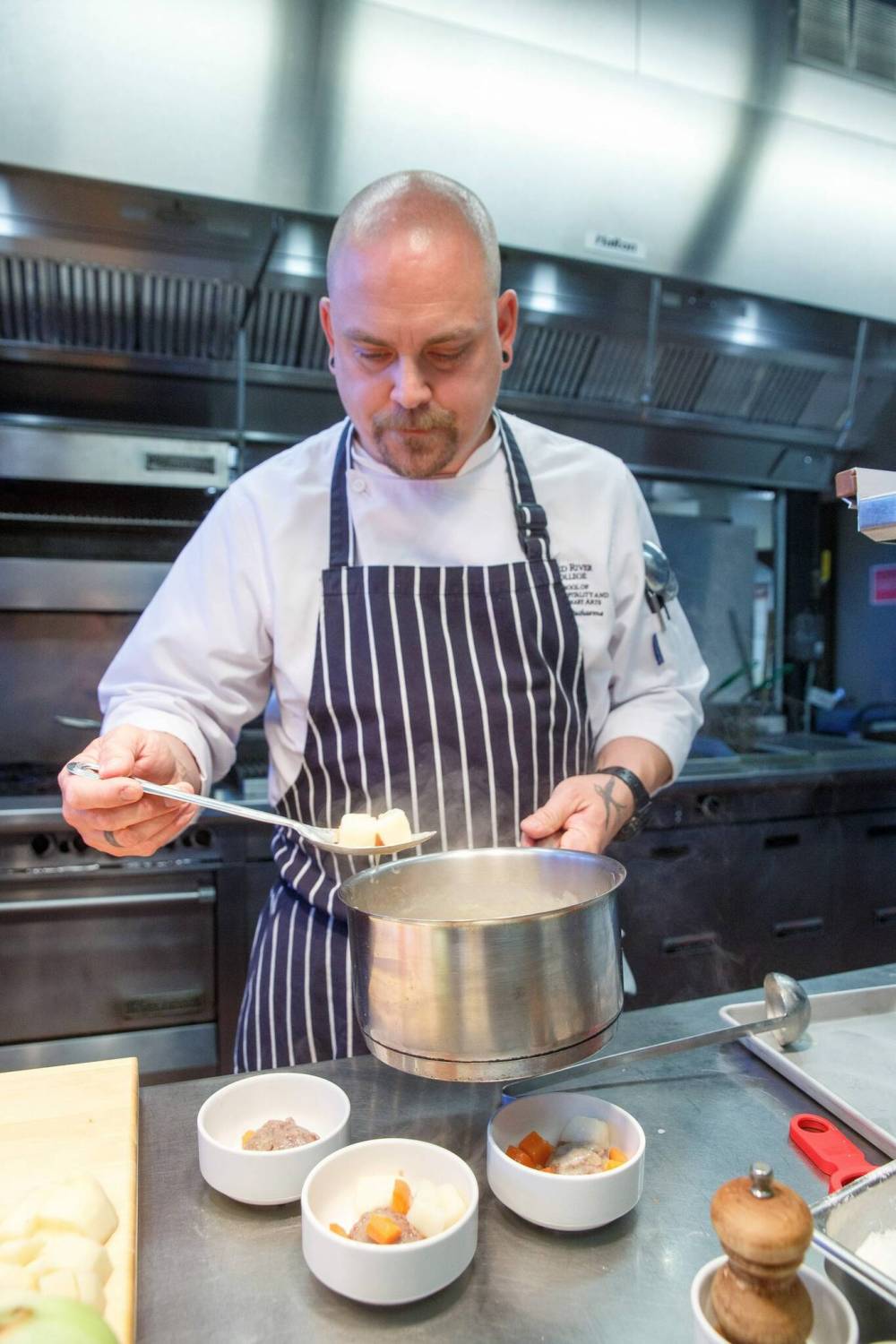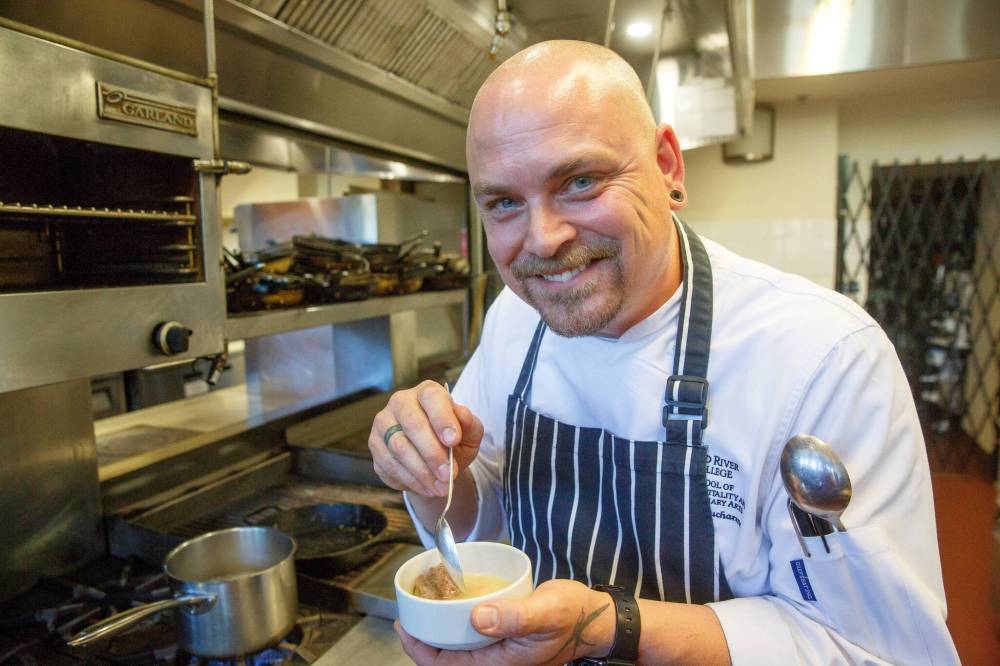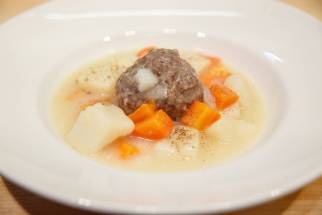Soup for the soul Warm memories of Métis dish sent culinary instructor on journey to explore his culture
Read this article for free:
or
Already have an account? Log in here »
To continue reading, please subscribe:
Monthly Digital Subscription
$0 for the first 4 weeks*
- Enjoy unlimited reading on winnipegfreepress.com
- Read the E-Edition, our digital replica newspaper
- Access News Break, our award-winning app
- Play interactive puzzles
*No charge for 4 weeks then price increases to the regular rate of $19.00 plus GST every four weeks. Offer available to new and qualified returning subscribers only. Cancel any time.
Monthly Digital Subscription
$4.75/week*
- Enjoy unlimited reading on winnipegfreepress.com
- Read the E-Edition, our digital replica newspaper
- Access News Break, our award-winning app
- Play interactive puzzles
*Billed as $19 plus GST every four weeks. Cancel any time.
To continue reading, please subscribe:
Add Free Press access to your Brandon Sun subscription for only an additional
$1 for the first 4 weeks*
*Your next subscription payment will increase by $1.00 and you will be charged $16.99 plus GST for four weeks. After four weeks, your payment will increase to $23.99 plus GST every four weeks.
Read unlimited articles for free today:
or
Already have an account? Log in here »
Hey there, time traveller!
This article was published 05/10/2022 (1158 days ago), so information in it may no longer be current.
Clinton Paul Ducharme is a formidable-looking man whose gentle demeanour belies his physical presence.
Broad-shouldered and muscular, Ducharme, 43, once harboured dreams of being an NHL player, but a burgeoning interest in food led him down a path that now sees him honing the skills of future chefs.
The culinary arts instructor at Paterson GlobalFoods Institute RRC Polytech will be cooking boulette today and has already assembled the meatballs for his soup.
“I wanted to make sure everything was ready,” he says by way of explanation. “This whole thing will take around 45 minutes.”
MIKE DEAL / WINNIPEG FREE PRESS Clint Ducharme plates a bowl of boulette, a meat and vegetable soup that takes him back to his childhood and reflects his Métis heritage.
The soup is a childhood favourite, standard home-cooked fare that he forgot about until rediscovering it on YouTube.
Watching it online brought back memories of eating boulette with his uncle Cliff, who had a commercial fishing unit in St. Laurent. They would spend the better part of the day pulling huge nets and taking fish out, Ducharme recalls, and feeling wet and tired after all that work.
“As a young kid I would go out with him on the lake. Getting changed and having a big bowl of this soup, either right after fishing or for supper, was pretty cool. Eating it brought me right back to being in the country, eating that really great, simple food.”
Homemade:Downtown Edition
It is often the simplest of foods which evoke the strongest of emotions.
That first cup of tea as dawn breaks, standing still before life comes crowding in. The perfumed sweetness of a fuzzy peach. A grilled cheese scarfed down in a rush between activities, leaving your tongue slightly burned.
The smell of buttery popcorn, salty on lips as you lean in for a first kiss at the cinema.
It is often the simplest of foods which evoke the strongest of emotions.
That first cup of tea as dawn breaks, standing still before life comes crowding in. The perfumed sweetness of a fuzzy peach. A grilled cheese scarfed down in a rush between activities, leaving your tongue slightly burned.
The smell of buttery popcorn, salty on lips as you lean in for a first kiss at the cinema.
Homemade: Downtown Edition is a monthly series inviting a person who works in Winnipeg’s downtown to cook and talk about their favourite comfort food; if we are what we eat, then who are you?
This series would not have been made possible without the generosity of staff at RRC Polytech, Paterson GlobalFoods Institute, who kindly permitted us to use the kitchens of Jane’s restaurant.
The memory kickstarted Ducharme’s exploration into his Métis background and culture. He says he is on his own “little journey,” discovering what Métis food is and how to define it.
“Is it using Indigenous ingredients? Does that make it Métis?” he asks. “I don’t know how you would even put it into its own box. If somebody is cooking Indigenous food, is it pre-contact Indigenous-style food? Wild meat? Cooking seasonally?
“That’s where I am looking into it myself: how do you classify it? I mean, there’s French, there’s Italian, but what is Métis food?”
What is it indeed? But then one can also ask what the food of Canada is.
With its large immigrant population, the cuisine of the country is wildly varied, an astonishing breadth of references snaking their way to tables across the country, sating desires for anything from a steaming bowl of Vietnamese pho to a plate of grilled lamb ribs rubbed with Middle Eastern spices to Cantonese dim sum, Jamaican goat curry and the ubiquitous butter chicken on every East Indian menu.
There are burger joints galore, Greek diners, Ukrainian cafés, Jewish coffee shops, French restaurants, Spanish tapas… the list goes on and on.
And that’s in Winnipeg alone.
The gateway to another culture is always through its food, long recognized as a way to bring people together. There is nothing so effective in breaking down barriers as when you sit at a table and break bread together.
We are spoiled for choice.
“That’s where I am looking into it myself: how do you classify it? I mean, there’s French, there’s Italian, but what is Métis food?”–Clinton Paul Ducharme
And yet there’s a startling lack of brick and mortar restaurants that specialize in Indigenous cuisine, in a city with the largest Indigenous population of any major city in the country.
How can this be?
“I think because it’s one of those things that never got to evolve. It never had a chance with the sort of the impression of things,” Ducharme says ruefully.
What impression?
‘Discrimination. Being Métis was kind of like a dirty thing. I know there are stories of people claiming to be French when in fact they are Métis, because of the discrimination of being Métis. It shouldn’t be this way.
“Feast Café Bistro is the only one, I think, with Indigenous food,” he says of the Ellice Avenue restaurant run by Christa Bruneau-Guenther. “The menu has wild game in it, there’s bannock involved… it is good food. I ate there before I even realized that Indigenous food can be a cuisine.”
MIKE DEAL / WINNIPEG FREE PRESS Flour is added to minced beef to act as a binder.
He realizes it now, he says, although he still struggles with defining it. Commonly eaten foods such as bannock and tourtière have their roots in Scottish and European cuisine, Ducharme explains.
“Maybe it’s a mix. European-style cuisine and regional ingredients, whether it be moose, elk, deer, wild rabbits or fish that is from your area. It can be hyper-local but because of where we live, in the middle of the city, you get lots of roots and tubers. Basically it’s seasonal cooking, I think. Lots of fresh veggies and meat in the summer and then preserved and pickled foods in the colder seasons. You have to cook that way: seasonally.”
Ducharme’s unearthing of his own roots has made him more determined to pass his knowledge to his son Silas, 5. He may only be at the beginning of his journey but for him it is of the utmost importance that Silas knows where they come from.
“Being Métis, I wanted him to have this cultural knowledge. I want him to know that part of who he is,” Ducharme explains. “I want to show him how to respect the land, plants and animals that come from it.”
MIKE DEAL / WINNIPEG FREE PRESS Clint Ducharme is all smiles during a taste test of his boulette soup, which reminds him of days spent fishing with his uncle.
Ducharme upholds his culture by continuing to keep it present in his life. Using the Michif language, learning about plant medicines and harvesting big game all connect him to his heritage.
“I have also just started to learn Métis-style fiddle; I feel like that instrument really speaks to my soul and I have a real draw to it,” he says.
Cooking Métis food is another way of keeping that connection alive. The recipe for boulette, which was made for Ducharme’s father Cy by his own grandmother, was pieced together by the two men after multiple conversations.
“I talked and talked to him and he gave me the green light and I made it with my son,” Ducharme recalls.
“When I finally made the dish, when I was eating, my wife was watching me and she said I was different, like it was hitting me in a different way. It was pretty powerful, just because of the nostalgic feelings and all that went along with it.
“It’s a simple and powerful dish for me.”
Making boulette forces Ducharme to lay down his chef’s hat and cook simply. Being professionally trained, he instinctively wanted to change it, he says. He had to stop himself from doing the things he would normally do with food.
“I found it really difficult. I wanted to try to this recipe but found it really hard to turn off the chef bit. Traditionally, there is no celery in it and if I started adding things that typically go in there then I am taking away from the authenticity of it and changing the core memory that I forgot about,” he explains.
“After rediscovering it, I’ve made it a few times without really changing anything. I try to keep it the way I had it as a kid, the way my dad had it.”
And the way he now has it with his son.
av.kitching@winnipegfreepress.com
Boulette Soup recipe
Recipe courtesy of Clinton Paul Ducharme
454 g (1 lb) ground beef
30 ml (2 tbsp) all-purpose flour
60 ml (1/4 cup) medium-small onion, diced
Salt and pepper to taste
1 medium carrot, large dice
1 medium red potato, large dice
Bring 1.5 l (6 cups) of water to a boil.
Break up the beef and add the salt, pepper, onion and flour. Mix until well combined.
Roll into balls just a bit larger than a golf ball, roughly 5 or 6 meatballs.
Roll each in flour to coat and place gently into the boiling water.
Bring the water back up to a boil, then down to a simmer and let cook for 35 minutes.
Add the large dice potatoes and carrots and cook until tender, approximately 10 minutes.
The soup is ready.

Our newsroom depends on a growing audience of readers to power our journalism. If you are not a paid reader, please consider becoming a subscriber.
Our newsroom depends on its audience of readers to power our journalism. Thank you for your support.
History
Updated on Wednesday, October 5, 2022 10:54 PM CDT: Adds new heads, formatting, related items








